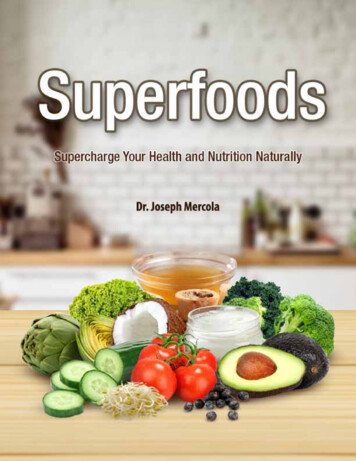
Transcription
Table of ContentsTable of Contents 1Introduction . . .3I.What Are Superfoods? . . .4II.Superfoods You Need to Get into Your Diet . . 5Top 10 Superfoods You Need to Get into Your DietWhat Makes Them a Superfood7 Equally Healthy But Lesser-Known SuperfoodsIII.Common Food Concerns That May Make Your Superfood Consumption Counterproductive .18Most Conventional Crops Are Now Genetically EngineeredPesticides in Produce Can Put Your Health at Grave RiskBuying Organic Superfoods Is Key to Safe Food ConsumptionTechniques to Maximize Food Absorption: Juicing and Fermentation IV.The Benefits of JuicingWhy You Should Ferment Your VegetablesGetting the Most Out of Your Superfoods 22Delicious Recipes Using Superfoods Tuscan Bean and Kale SoupSlow Roasted Garlic and TomatoesFennel-Dill ArtichokesBlueberry Acai SmoothieRed Peppers and Broccoli with Ume Tarragon DressingMinted Cucumber SoupRye Crisp “Sandwich” with Avocado, Sprouts, and Sheep’s CheeseSprout Stuffed AvocadosBasic Bone Broth Recipe3 Supercharged Juice Recipes Using Superfoods Green Goodness JuiceOh Sweet Broccoli Juice!Pineapple JuicePractical Shopping, Preparation, Cooking, and Storage TipsV.Growing Your Own Superfoods .33Selecting Your SoilCollecting Your CompostThe Wonders of Wood ChipsSolving the Space Problem: Container Gardening Super Sprouts Planting and Harvesting SproutsMicrogreens DIY Microgreen GardenHerbs Starting Your Own Herb Haven at HomeThe Best Superfood to Grow for Every SeasonConclusion 45Sources and References 47Superfoods: Supercharge Your Health and Nutrition Naturally1 Page
IntroductionThe Basics of Healthy Eating: How Superfoods Add a Super Boost to Your DietAre you suffering from the perils of poor health? Is your immune system constantly challenged,making you prone to illnesses and health hurdles that are getting in the way of living life to thefullest?If you answered “yes” to these questions, then there’s probably one very crucial lifestyle factorthat you’re overlooking: your diet.I believe that your overall health – physical, mental, and emotional – is a direct reflection ofwhat you put in your body. Unfortunately, much of the food most people eat today are highlyprocessed and adulterated – very different from the fresh, wholesome foods that our ancestorsconsumed many years ago.Consuming a Processed Food Diet Wrecks Your HealthThree decades ago, most of the food that people ate was fresh and grown locally. Today, themajority of meals served at home, restaurants, and even in schools are made of highlyprocessed foods that are loaded with sugars, harmful processed fats, and chemical additives.Overall, at least 90 percent of the food budget of a typical American family is spent onprocessed foods, including restaurant foods and grocery fares that require little to nopreparation time at all.This, in my opinion, is what’s causing the incessant cycle of disease and poor health that manyAmericans are predisposed to today. Combine it with a sedentary lifestyle, poor stressSuperfoods: Supercharge Your Health and Nutrition Naturally2 Page
management, and constant exposure to toxic chemicals, and you’ve got the perfect recipe fora health disaster.So what can you do to solve this problem? The answer is simple: Eat fresh, healthy, organic,wholesome foods.Healthy organic foods will not only give you a variety of life-giving nutrients and will provideoptimal fuel for your cells and tissues, but they will also help bolster your immunity andmaintain your healthy weight.But how would you know what the best foods to eat are? No need to look further.The Superfood Advantage: Top Superfoods You Can Add to Your MealsIn this E-book, Superfoods: Supercharge Your Health and Nutrition Naturally, I’ve created a listof the best superfoods today – nutrient-dense foods that can provide you with body-widebenefits.These superfoods – fruits, vegetables, and healthy fats – can not only provide you with a widerange of vitamins, minerals, and other essential nutrients, but can also be easily integrated intoa balanced diet.What’s more, this superfood E-book will also enlighten you on numerous topics, such as: The definition of “superfood” and how to grow (and prepare) the best ones in thecomfort of your homeLesser-known but equally nutritious superfoods you may have never heard of beforeFactors that might make your superfood consumption counterproductive and how toavoid themI’ve also compiled several healthy and delicious recipes that use these superstar ingredients.Satisfy your family’s taste buds as you nourish their bodies with these wholesome dishes.If you’re new to the idea of healthy eating, then I believe that you should incorporate as manyof these superfoods as you can into your diet plan.Start reading this E-book now and add high-quality superfoods to your meals. This simple butsignificant change in your eating habits may be the ultimate secret that will help you takecontrol of your health. Dr. Joseph MercolaSuperfoods: Supercharge Your Health and Nutrition Naturally3 Page
Chapter I:What Are Superfoods?In 2004, Dr. Steven Pratt, author of Superfoods Rx: Fourteen Foods That Will Change YourLife, coined the term “superfood” – and much of what we knew about the food that we eattoday began to change.There is no official definition of the word “superfood,” but the Oxford Dictionary describes it as“a nutrient-rich food considered to be especially beneficial for health and well-being.” iContrary to popular belief, superfoods are not just limited to plant-based fruits or vegetables,but also include cuts of protein, dairy options, and certain grains. The superfood concept doesnot exist to serve as just a type of food that can help with weight loss, but promote overallhealth and wellness. “It’s the non-diet diet. It’s food you can eat for a lifetime,”ii Dr. Pratt toldCNN a few years back.As Dr. Pratt notes, there are three qualities that separate superfoods from the rest of the pack:1. Availability. Superfoods should be accessible to everyone. You should be able toeasily purchase it at a local supermarket, farmers’ market, or from a trusted sourceonline, depending on your location.2. Presence of nutrients known to enhance longevity. Superfoods commonly haveabove-average quantities of natural health-boosting and disease-fighting nutrients,including antioxidants, phytonutrients, and essential fatty acids, proving that they are a“bang for your buck” and are worthy of the superlative. iii3. Health benefits backed by peer-reviewed and scientific studies. To make the cut,claims of anti-aging, disease protection, and other health benefits coming from theseincredible edibles must be supported by solid scientific evidence.Superfoods: Supercharge Your Health and Nutrition Naturally4 Page
Chapter II:Top 10 Superfoods You Need to Get into Your DietNutrition is one of the most crucial pillars of health you definitely want to focus on if you’reseeking to live a long and healthy life, as it has such a profound impact on your well-being.What you fuel and nourish your body with on a daily basis not only says a lot about the currentstate of your overall health, but the way it performs and survives once the going gets tough. Ifyou’re used to eating pre-packaged processed and junk foods, which more often than not aredeficient in essential nutrients and smothered with artificial chemicals, for the sake ofconvenience, then easily going down with a cold or infection every now and then may be afamiliar scenario for you.On the contrary, a diet of natural wholesome foods, densely packed with an array ofremarkable vitamins and minerals, such as superfoods, can give you a well-nourishedphysique that is strong enough not only to fend off diseases, but to also help you live your lifeto the fullest.To help you get started, I’ve listed down 10 of my favorite superfoods. Check them out:1. Kale (Borecole)Probably one of the healthiest leafy greenvegetables you can munch on, kale has beenaround since the Roman times. Because kale isvery easy to grow and even thrives during thecold winter season, its cultivation was highlyencouraged in the United Kingdom by the DigVictory campaign during World War II. ivSome of the more popular varieties of kale include curly kale, Lacianto kale (dino kale),red Russian kale, redbor kale, and Siberian kale. There are countless ways to enjoykale. You can cut the smaller, paler green leaves to anchor or mix into fresh gardensalad, while the larger, dark greens are great for stir-fries, pizza topping, or soup. Youcan even indulge in guilt-free kale chips!Superfoods: Supercharge Your Health and Nutrition Naturally5 Page
What Makes It a Superfood?A single cup of kale can trump a whole week’s worth of other foods as it contains: 684 percent of the daily value of vitamin K206 percent of the suggested daily amount of vitamin A134 percent of vitamin C (and even more vitamin C in the Scottish curly-leafvariety)Kale has been compared to beef, which is known as a “go-to” food for iron, protein, andcalcium. It has anti-inflammatory properties linked to the prevention and reversal ofcertain diseases, which includes arthritis, heart disease, and several autoimmunediseases, at levels not seen in other green vegetables.2. Tomato (Lycopersicon esculentum P. Miller)A member of the nightshade family, the first speciesof tomato plants originated in the South AmericanAndes, although its use as a food was initiated by theMexicans and was spread all throughout the worldduring the Spanish colonization. vThere are over a hundred of varieties of tomato – tiny types like grape, plum, and cherryfor snacking pleasure; firm, petite Romas good for cooking; and hefty beefsteak, idealfor BLTs and burgers. These plump mouthwatering superfoods can be used in manyways: sun-dried, fried green, stew, sauce, paste, ketchup, juice, Bruschetta, veggiesoup, pizza, salsa, salad the list goes on and on.What Makes It a Superfood?Tomatoes are rich in flavonoids and other phytochemicals that have anti-carcinogenicproperties. One of them is lycopene, a carotenoid antioxidant that gives fruits andvegetables like tomatoes and watermelons a pink or red color. More powerful than othercarotenoids, lycopene may significantly reduce your risk of stroke and prostate cancer.Other lesser known phytonutrients found in tomatoes include: Flavonols: rutin, kaempferol, and quercetinFlavonones: naringenin and chalconaringeninHydroxycinnamic acids: caffeic acid, ferulic acid, and coumaric acidGlycosides: esculeoside AFatty acid derivatives: 9-oxo-octadecadienoic acidSuperfoods: Supercharge Your Health and Nutrition Naturally6 Page
In daily value, tomatoes provide 38 percent vitamin C, 30 percent vitamin A, and 18percent vitamin K – minus the fat and cholesterol.3. Artichoke (Cynara scolymus)Artichoke is a perennial thistle and is a member of thesunflower family of vegetables. First cultivated in theMediterranean region, artichokes became scarceafter the fall of the Roman Empire. They made acomeback in Italy in the 1500s, and then appeared inthe Americas after introduction by French andSpanish gardeners. As of today, California is thelargest producer of artichokes in the US.Some popular types and varieties of artichokes include: Globe artichokesElongated artichokesPurple baby anzioOblong sienaFiesole artichokeChiantiArtichokes can either be steamed and served with a dipping sauce, stuffed with all kindsof savory ingredients like vegetables, lightly steamed then grilled, mixed into salads,and added in stews and other hot dishes.What Makes It a Superfood?Artichokes are a good source of fiber, as it supplies at least 28 percent of therecommended daily value. Aside from helping you move waste out of your systemregularly, fiber can help also: Lower blood sugar and blood pressure levelsPrevent inflammation and protect heart healthReduce your lipoprotein or "bad" cholesterol levelsThe cynarin in artichokes increases bile production in your liver, which in turn eliminatebad cholesterol from your body. It also offers 25 percent of the daily requirement ofvitamin C, or ascorbic acid, which provides antioxidant action to protect cells fromdamaging free radicals. Vitamin C also supplies collagen to help wounds heal quicklyand protects the body from disease by helping it absorb iron.Superfoods: Supercharge Your Health and Nutrition Naturally7 Page
4. Acai berries (Euterpe oleracea)Acai (pronounced ah-sigh-ee) berries looks like anoffspring of a grape and a blueberry with a tastereminiscent of wild berries and chocolate. These tiny,reddish-purple drupes consist of a cluster of seeds,with only 15 percent or so being edible. Native toSouth America, acai berries are harvested from thetall, slender palm trees found at the basin of theAmazon River.Although acai berries can be found in large supermarkets and health food stores aroundthe globe, they’re only available as a juice or tea rather than fresh fruits. Becausethey’re highly perishable, getting acai berries out of the Amazon with their nutrients stillintact is nearly impossible.As a food, acai pulp in the tribal Amazon belt is often blended with the starchy rootvegetable manioc and eaten as porridge.What Makes It a Superfood?Acai is known for its extraordinary antioxidant properties similar to cranberries, butmany times more than what is found in blueberries and strawberries. As a matter of fact,the Oxygen Radical Absorbance Capacity (ORAC) values measuring the antioxidantpower of acai fruit pulp/skin powder reportedly have the highest ORAC value amongfruits and vegetables, or 10 times more antioxidants than red grapes.This is why it’s not surprising to find that acai berries may help treat:DiarrheaParasitic infectionsHemorrhagesUlcersErectile s: Supercharge Your Health and Nutrition Naturally8 Page
Acai berries are low in fructose, but contain excellent amounts of iron, calcium, fiber,and vitamin A. They also contain anthocyanin compounds, such as resveratrol,cyaniding, and ferulic acid, which not only give fruits and vegetables their distinct color,but also team up with flavonoids to defend your body against harmful free radicals. Infact, acai berries offer 10 to 30 times more anthocyanin power than red wine.5. Broccoli (Brassica)Broccoli is perhaps the most popular member of thecruciferous group of vegetables. The word “broccoli”means “branch” or “arm” for the cross-shaped stems,like mini trees bearing the blossoms.A valuable vegetable that’s loved by the ancientRomans, broccoli once grew wild on the shores of theMediterranean Sea. Its use can be traced to 16thcentury France and England in the 1700s, with commercial growth beginning in the USin the 1920s.While there are many ways to prepare and enjoy this superfood – it can be steamed,roasted, baked, sautéed, or stir-fried – broccoli is best eaten raw, as cooking tends todestroy some of its antioxidant components.What Makes It a Superfood?Broccoli has twice the vitamin C of an orange, almost as much calcium as whole milk(with a better rate of absorption), and offers anti-cancer and anti-viral properties with itsselenium content. Just one cup of broccoli provides over 100 percent of your daily needfor vitamin C and vitamin K, and is also a good source of vitamin A, folate, andpotassium.Some of the most sought-after health benefits of broccoli include: vi,viiAnti-cancerAnti-inflammatoryImproved digestion and natural detoxificationCardiovascular supportProtection from chronic diseasesEnhanced bone healthSuperfoods: Supercharge Your Health and Nutrition Naturally9 Page
6. Cucumber (Cucumis sativus)Considered the most widely cultivated vegetable inthe world, cucumber is technically a fruit from theCucurbitaceae family of gourds, alongside differentvarieties of pumpkins and melons. Cucumber offers arefreshing flavor that blends beautifully with otherfruits and vegetables.It originated in the Mediterranean and was brought tothe Americas by European explorers in the 1500s. There are dozens of cucumbervarieties thriving in both cool and warm climates, but three of the most prevalent onesare slicing, pickling, and burpless.To get cucumbers into your diet, you can try pickling them or adding them to yoursalads, juices, and other cooked recipes. Infusing your water with slices of cucumber isanother must-try.What Makes It a Superfood?Grown wild throughout India, cucumbers are used as a traditional medicine to treatheadaches. The seeds have found a niche as a diuretic, and the juice is used as anacne cream and a soothing remedy for tired, puffy eyes. These early uses led scientiststo investigate cucumber fruit, seeds, and extracts as an effective treatment in otherareas of medicine.Although it’s actually 90 percent water, cucumber doesn’t skimp on nutritional value. It’san excellent source of: Anti-inflammatory vitamin KInfection-fighting vitamin CEnergy-producing pantothenic acid (vitamin B5)Bone-building manganeseHeart-healthy potassium and magnesiumRecent studies also reveal that cucumbers also have lignans, the unique polyphenols incrucifers and alliums, such as cabbage and onions, known to lower heart disease risk.In cucumbers, these powerful lignans bind with estrogen-related bacteria in thedigestive tract, contributing to a reduced risk of several cancers, including breast,uterus, ovarian, and prostate cancers. Other phytonutrients in cucumbers calledcucurbitacins – part of a larger group known as triterpenes – are also known to stronglyinhibit cancer cell development.Superfoods: Supercharge Your Health and Nutrition Naturally10 P a g e
7. Avocado (Persea Americana)Avocado is a cousin to cinnamon, camphor, baylaurel, and other members of the Lauraceae family.Spanish conquistadors had their own historian,Oviedo, who reported positively about avocadosdiscovered in Mexico around 1519. But thisinteresting fruit has graced Central and SouthAmerica for perhaps 10,000 years, according to theavocado-inspired drawings and artifacts found inearly Aztec settlements.A judge from Santa Barbara took the first Mexican avocado trees to California in 1871.California now grows 90 percent of the US avocado crop in more than 6,000 groves.What Makes It a Superfood?When it comes to nutrition, avocados are a different breed, because of theextraordinarily huge quantity of benefits they offer. Loaded with fiber, a single avocadocontains: 36 percent of the daily requirement for vitamin K30 percent for the folate20 percent each of the daily requirements for vitamins B5, B6, C, and potassiumMore importantly, avocado is one of the few fruits that will provide you with "good" fats,which means it can help keep your cholesterol levels already in the healthy range andhelp lower your risk for heart disease.8. SproutsSprouts are the edible germinated seeds of flowers,beans, legumes, vegetables, or grains. Sproutsdeserve to be called a superfood not only becausethey can be grown effortlessly and inexpensively, butalso because they contain exceptional amounts ofvitamins and minerals, sometimes way beyond whata mature plant can offer.Superfoods: Supercharge Your Health and Nutrition Naturally11 P a g e
This is because when sprouting seeds, nuts, beans, and grains you get: Higher amounts of vitamins and enzymesIncreased essential fatty acid and fiber contentIncreased bioavailability of minerals and proteinA rising superstar in the raw food community, sprouts are typically eaten raw and addedin salads, juices, sandwiches, and other recipes.What Makes It a Superfood?Despite their size, sprouts should never be underestimated. These little edibles are apowerhouse of nutrients. For instance, sunflower sprouts and pea shoots are known tobe up to 30 times more nutritious compared to organic vegetables.Here are a few more sprout options you can choose from and some of the nutrients theyhave in store for you: Alfalfa – vitamins A, B, C, D, E, F, and KWheatgrass – vitamins B, C, and EMung bean – protein, fiber, and vitamins C and ALentil sprouts – 26 percent protein and can be eaten without cookingBrussels sprouts – fiber, manganese, potassium, choline, B vitamins,antioxidants, and other health-promoting phytochemicals9. Coconut OilCoconut oil is the edible oil extracted from the whitemeat of mature coconuts. It is most commonly usedin many tropical countries, particularly in India, SriLanka, Thailand, and the Philippines, where coconuttrees thrive well. Because of the coconut’sinnumerable health and wellness boons, coconut oiland other coconut products, such as coconut water,are gaining popularity in the West.Aside from being an ideal oil to use in all forms of cooking and baking (because it canwithstand high temperatures without being damaged like many other oils), coconut oilcan also be drizzled over salads, added in coffee or vegetable juices, or taken as isonce or twice daily.Superfoods: Supercharge Your Health and Nutrition Naturally12 P a g e
What Makes It a Superfood?Coconut oil is an ideal replacement for non-vegetable carbohydrates, because it iscomprised of medium-chain fatty acids (MCFAs) that are easily digested and readilycross cell membranes. These MCFAs are immediately converted by your liver intoenergy rather than being stored as fat.Coconut oil also has potent antimicrobial properties, which make it a powerful destroyerof all kinds of microbes, from viruses, to bacteria, to protozoa. Coconut oil also helps: Promote heart healthSupport proper thyroid functionPromote healthy brain functionStrengthen your immune systemProvide an excellent "fuel" for your bodySupport a strong metabolism that can aid in weight lossMaintain healthy and youthful looking skin10. Homemade Bone BrothBone broth is made with bones and sometimes asmall amount of meat adhering to the bones ofdifferent kinds of animal meat – whether it’s beef,pork, chicken, or fish. It’s typically simmered for asignificant period of time, which can sometimes evengo beyond as 24 hours, to produce a gelatinous soup.Basically, the more gelatinous the bone broth, themore nourishing it tends to be. The collagen thatleaches out of the bones when slow-cooked is one ofthe key ingredients that make broth so healing.A timeless superfood, according to Dr. Kaayla Daniel, vice president of the Weston A.Price Foundation and co-author (with Sally Fallon Morell) of the book Nourishing Broth,bone broth goes back to the Stone Age, when they were actually cooking broth in turtleshells and in skins over the fire. The great Greek physician Hippocrates was also knownto be a big believer in its benefits.Today, Los Angeles Lakers player Kobe Bryant is among those who swear by bonebroth and who believes it has kept his NBA career sustainable, having it as a foundationof his pre-game meals. "I've been doing the bone broth for a while now. It's great [for]energy and inflammation. It's great," the NBA star reportedly said in one of hisinterviews with ESPN.Superfoods: Supercharge Your Health and Nutrition Naturally13 P a g e
What Makes It a Superfood?Bone broth contains a variety of valuable nutrients of which many Americans are usuallylacking, in a form your body can easily absorb and use, such as: Calcium, phosphorus, and other mineralsComponents of collagen and cartilageSilicon and other trace mineralsComponents of bone and bone marrowGlucosamine and chondroitin sulfateThe "conditionally essential" amino acids proline, glycine, and glutamineStill not convinced? These additional health perks brought by bone broth might changeyour mind: Reduces joint pain and inflammationInhibits infection caused by cold and flu virusesFights inflammationPromotes strong, healthy bonesPromotes healthy hair and nail growthSuperfoods: Supercharge Your Health and Nutrition Naturally14 P a g e
7 Equally Healthy But Lesser-Known SuperfoodsIf you want to try something new, you can satisfy your palate with these less-popular butequally nutritious superfoods featured in Time magazine:1. Limequat. A cross between lime and kumquat,limequats are in season between July and November,and contain plenty of fiber and vitamin C. Like thekumquat, they have an edible rind, so it's a goodchoice for spicing up dishes with a citrusy flavor.2. Pomelo. Yet another member of the citrus family thatis typically overlooked, pomelos look a bit like oversized grapefruits, and the taste is similar too, although pomelos tend to be sweeter.The significant vitamin C content in pomelo acts asan antioxidant that helps slow down aging. The richsupply of key nutrients in pomelo, such as potassium,dietary fiber, and magnesium, also helps: viii Prevent osteoporosis and bone weakness Fight microbial, viral, and bacterial infections Eliminate constipation and diarrheaReduce risk of atherosclerosis, heart attacks, and strokesIncreases blood circulation and oxygenation of organs3. Hubbard Squash. A winter produce, Hubbardsquash come with loads of nutrients, includingvitamins A, C, E and K, potassium, folic acid, iron,lutein, manganese, magnesium, phosphorus,zeaxanthin, and plant-based omega-3. It’s bestenjoyed roasted and with kale, or added into asteaming pot of stew.Superfoods: Supercharge Your Health and Nutrition Naturally15 P a g e
4. Teff. A tiny North African cereal grass grain, teff has been a staple of traditionalEthiopian cooking for thousands of years. Apart from being naturally gluten-free, hereare a some more reasons why teff should be a part of your everyday diet: It helps manage blood sugarIt helps regulate your bowel movementIt is low in sodiumIt is rich in calcium, manganese, iron, fiber,protein, B vitamins, zinc, and all eight essentialamino acidsIncluding teff into your everyday meals is easy-peasy, since it has a mild, nutty flavorthat lends itself well to a variety of dishes, including stews, pilaf, and baked goods. Youcould also use it as a salad topping.5. Fenugreek. Its curry-scented leaves are edible and are often used as an ingredient inauthentic Indian cuisine, while its seeds are used as a flavorful spice. Fenugreek seedsare rich in minerals like iron, potassium, calcium, fiber, choline, and can be sprouted foran added health kick as well.Over the years, fenugreek has also been the focus ofseveral studies concerning the treatment of diabetesand the prevention of breast cancer. But traditionally,fenugreek has been valued for its medicinal usesfor: ix Digestive problemsConstipationGastritisBronchitisSore throatDiabetesUlcer6. Purslane. Purslane is a lemon-flavored edible weedthat is popular in both Greek and Mexican cooking.Some compare its taste to watercress or spinach. It'srich in plant-based omega-3 fats, vitamins C and E,and pectin. Young leaves and tender stem tips aregenerally preferred in terms of flavor and crunch, andmake a tasty addition to salads and sandwiches.Superfoods: Supercharge Your Health and Nutrition Naturally16 P a g e
7. Celeriac. Also known as turnip-rooted celery or celery root, celeriac is a root vegetablewith a taste that resembles conventional celery. Celeriac is high in vitamins B6, C, andK, along with potassium, and magnesium. It is also proven to help aid in: Improving bone healthEnhancing brain functionFighting damaging free radicalsMaintaining a healthy blood pressure levelPreventing cancerYou can eat celeriac either raw or cooked. Timemagazine, on the other hand, suggests grating a littleceleriac onto your salad, along with beets, apples, and walnuts, for an added punch.Superfoods: Supercharge Your Health and Nutrition Naturally17 P a g e
Chapter III:Common Food Concerns That May Make Your SuperfoodConsumption CounterproductiveBefore you start loading up your shopping cart with the superfoods I mentioned in the previouschapter, keep this in mind: not all foods you see in the grocery are as healthy as they seem. Infact, even the most innocent-looking produce may expose you to certain health dangers.Consider this: in June 2011, vegetable sprouts from Germany killed over 30 people andsickened over 3,000. The sprouts were found to be contaminated with Escherichia coli (E. coli)O104:H4. Aside from the usual stomachache, the victims experienced severe symptoms, suchas anemia and kidney failure.But it’s not just in Germany. According to Bill Marler, a personal injury attorney who specializesin food-borne illnesses, there have been over 40 “sproutbreaks” since 1990 in the US alone. xIt’s quite unfortunate since sprouts, which are among the healthiest and most nutrient-densefoods on the planet, are given a bad rap.But that’s just the tip of the iceberg, as conventional foods are actually plagued with plenty ofhealth and safety issues that, if you’re not careful, can severely wreak havoc on your health.Most Conventional Crops Are Now Genetically EngineeredGenetically modified organisms (GMOs) are crops produced via genetic engineering. Thegenetic makeup of these “specialized crops” has been altered to induce a variety of uniquetraits, such as making them “drought- or pest-resistant,” or fortifying them with “more nutrients.”Today, up to 85 percent of U.S. corn, 88 percent of cotton,and 91 percent of soybeans are genetically modified. It isalso estimated that at least 80 percent of processed foodsnow contain genetically engineered ingredients. Geneticengineering has been deemed safe and beneficial by GEproponents, mainly by biotech companies like Monsanto.Sadly, nothing can be further from the truth.Not only is genetic engineering a power-hungry technology that severely harms theenvironment, but it also has potentially damaging effects on your wellbeing. For example, i
The Superfood Advantage: Top Superfoods You Can Add to Your Meals . In this E-book, Superfoods: Supercharge Your Health and Nutrition Naturally, I've created a list of the best superfoods today - nutrient-dense foods that can provide you with body-wide benefits.










